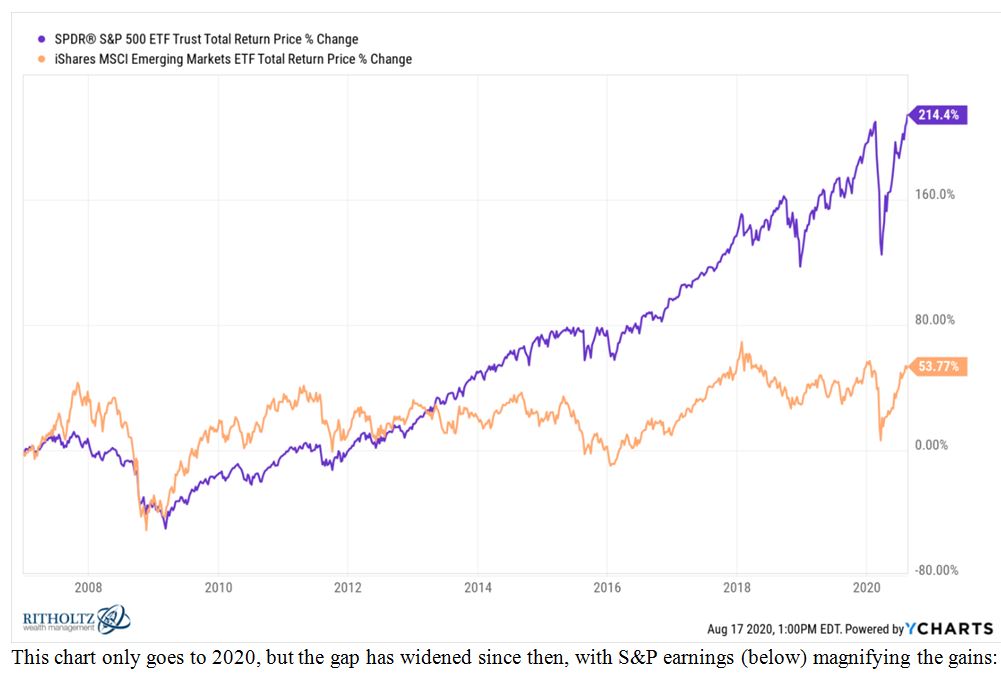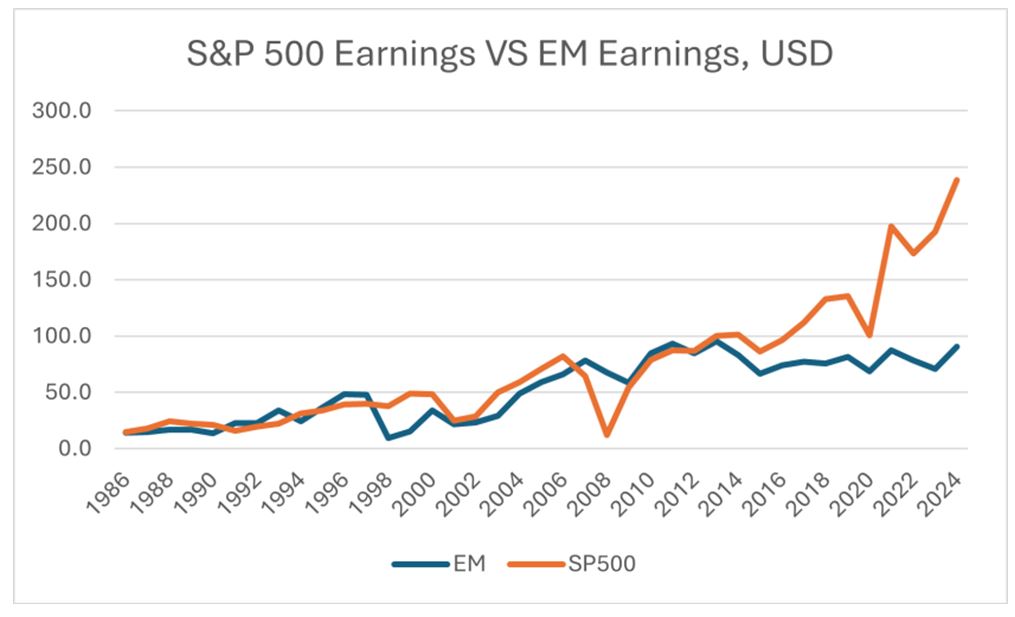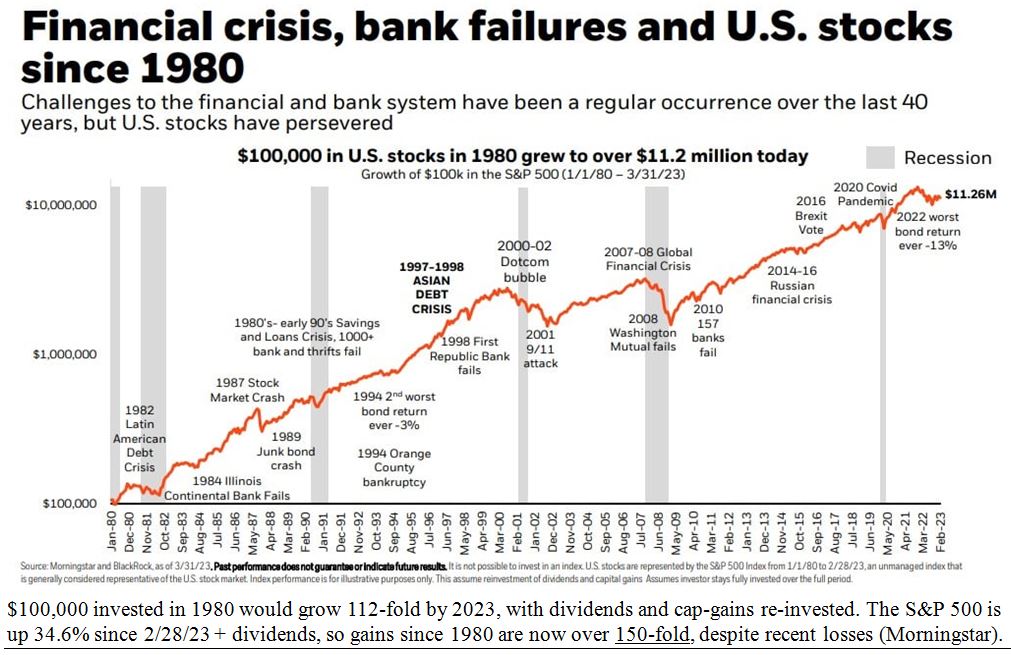by Gary Alexander
August 13, 2024
It’s as predictable as hurricanes in August and September. Markets get volatile; the perma-bears predict that this is the beginning of the “worst crash ever;” the media broadcast their worst nightmares widely, since bad news sells. Then, as predictably as autumn leaves fall, the market recovers in the fourth quarter.
Perma-bear Jeremy Grantham on his “We Study Billionaires” podcast last Thursday said, “This is the most vulnerable market there has ever been.” He cited the Japanese asset bubble in the late 1980s, the dot-com bubble at the turn of the century and the mid-2000s housing bubble, all including 50%+ market crashes.
“Most vulnerable market EVER” encompasses 1929, 1973, 2000 and 2008. Those markets collapsed by 89% (Dow), -48% (S&P 500), -78% (NASDAQ) and -55% (S&P 500), respectively, but those markets also had rapid, manic “bubble” bidding, stagflation, lack of earnings support, and high leverage, respectively.

Grantham is 85 and has been doing this a long time, since founding GMO LLC 1977, when the Dow was under 1,000, and the S&P 500 and the new NASDAQ were both under 100. Grantham built his reputation around being right about some earlier bubbles, but he has been wrong for most of the last 15 years.
Forbes Magazine attended one of Grantham’s bearish rallies in Chicago almost a decade ago, writing:
“For long-term observers of Jeremy Grantham, the chief of GMO LLC and erudite analyst of world investing trends, there’s never a moment when you see Grantham gush about investment trends. There’s a reason why he’s nicknamed the ‘perma-bear.’
“Last night at Chicago’s Morningstar conference, as in past talks in recent years, Grantham was ever the cautionary Cassandra, weaving in dire scenarios …. In Grantham’s long-term forecasts, though, which stretch out seven years, big U.S. stocks will barely eke out a gain while the biggest winners are in emerging-markets and timber….”
—-Forbes, June 25, 2015, Grantham’s Bubble Gun Hasn’t Been Triggered Yet, by John Wasik
Grantham repeated this advice in 2018, according to Bloomberg: “Grantham has a battle plan for an overvalued U.S. stock market: Allocate heavily to emerging-markets equities.”
That has not been the best way to invest since 2018. The iShares MSCI Emerging Markets fund has been flat since early 2018, while the S&P 500 is up five-fold, and the earnings gap has magnified that gain.

Graphs are for illustrative and discussion purposes only. Please read important disclosures at the end of this commentary.

Graphs are for illustrative and discussion purposes only. Please read important disclosures at the end of this commentary.
Last November, Grantham said that the S&P 500 could dip below 3,000 (it’s currently over 5,300), or crash by over 50% “if a couple of wheels fall off.” This is an old song for him. On October 14, 2022, after the S&P had fallen 17% in two months, Grantham predicted it would fall a total of 40%, but October 14 was when the market started rising (Business Insider, “A 26-year market vet breaks down why investing legend Jeremy Grantham is correct to compare the current market to the 2000 and 2008 ‘super bubbles’ – and warns stocks will fall another 20%,” October 15, 2022).
Last week, we also heard from billionaire fund manager Mark Mobius, 87, who reportedly told The Economic Times that the recent sell-off in stocks could be a warning sign that there is more trouble ahead.
How Come Nobody Warns of a “Market Melt-Up” Before It Happens?
History is replete with bears who constantly warn of a “coming crash.” I’ve followed a fellow who has predicted a “Greater Depression” for the last 45 years, missing a 50-fold Dow gain. In the 1920s, Roger Babson was famous for predicting a crash every year, until it finally happened in 1929, but he missed a 5-fold bull market first. Now we have this curmudgeon Grantham, missing big gains since 2015.
Why don’t we hear about the success of the “perma-bulls,” who predicted big gains in the early 1980s, when everyone else seemed to be citing “cycles” and “bubbles” as reasons to get out of the market?
In 1982, as I recall, several pundits were citing the Kondratieff 50-year cycle as a reason for getting out of stocks, when that exact cycle said it was the perfect time to get back into stocks. What they didn’t realize is that the exiled Soviet economist Nikolai Kondratieff was right – the parallels of 1929-32 were nearly perfect in the 1980s, but this time we made the right choices to avoid a deeper depression in the 1980s.
Consider these 50-year parallels:
- The American economy contracted drastically from 1929 to 1932… and 1979 to 1982.
- The stock market more than tripled from 1932 to 1937 … and from 1982 to 1987.
- There was another huge market crash in 1937 … and in October 1987.
- The market rally resumed only after war broke out in 1941 … and in 1991 (the Gulf War).
The market turned around precisely on this calendar date, August 13, 1982, with a lucky Dow low of 777.
The gains since then are phenomenal – by some measures over 150-to-1:

Graphs are for illustrative and discussion purposes only. Please read important disclosures at the end of this commentary.
Did anyone scream “buy” in 1982? Yes – at least two pundits, both of whom I later worked with:
(1) In 1981 and 1982, Mark Skousen, editor of Forecasts & Strategies, went against the grain of the gold-enamored newsletter community, predicting “Reaganomics Will Work,” i.e., that the supply-side implications of the Kemp-Roth tax bill would fuel a dramatic U.S. stock market rally.
(2) John Dessauer, editor and publisher of “Dessauer’s Journal” (later “Investor’s World”) also predicted a “buying panic” in late 1982. At the start of the year (January 6, 1982), he predicted “A new record high on the DOW…before the sun sets on 1982.” On August 4, 1982, just a week before the turnaround, he wrote (in bold, all-caps, like this), “THE RISK AT THIS POINT IS A DRAMATIC UPTURN…. a sudden burst of optimism that carries stock prices higher without warning…. Throw away the rule book. When the run comes, stock prices will move up fast.” (The market rose 30% in the next two months, to set new all-time highs by the end of 1982).
Why did most other observers miss the market bottom? They were slaves to past trends and waves. They compared 1982 to 1929 (instead of 1982 to 1932), without learning the lesson: That which we most fear is least likely to happen. That which most scarred us has taught us the deepest lessons. We will never let the 1930s happen again because it hurt so bad. Economists at the Fed will never let the 1930s happen again.
August 1982 started out with eight straight down days, as Fed Chairman Paul Volcker’s tight monetary policy threatened to bring on deflation in the midst of our worst postwar recession, but Volcker didn’t seem to care. In early August, Volcker went on a fishing trip in Mexico, even as economic panic loomed.
America was in the depths of the second of two severe back-to-back recessions, the worst slowdown since the 1930s. From mid-1979 to the end of 1982, there were 14 quarters of net negative growth. The Prime Rate hit 21.5%; unemployment hit 11.2%; inflation reached 13% in 1980, but then slipped below 4% by mid-1982, threatening deflation, so finally the Fed Chair blinked and flew home from his fishing trip.
The market was also fishing – for a low. In the first four days of the week, the market fished for a bottom:

Then, Volcker began easing the Discount Rate. The first cut was a full point, from 11% to 10%. That caused the market to stop falling. Then he lowered the Discount Rate five more times in the second half of 1982, down to 8.5%. Short-term (90-Day) T-bills declined from 13.3% to 7.8% in the third quarter and banks lowered their Prime Rate from 21% to 13% as the Fed was determined to flood the market with new liquidity after the failure of Penn Square Bank and a raft of August deflationary indicators came out:

After 200 years of rapid growth, America seemed to be in decline. From 1973 to 1982, U.S. GDP had declined in 11 of 40 quarters, but inflation doubled prices in that decade. At this panic bottom, Fed Chair Volcker had throttled inflation, and the Dow gained 250% in five years, and 50-fold in the last 42 years. (And over 100-fold gains in the S&P 500, assuming reinvested cap-gains and dividends, per above chart).
All content above represents the opinion of Gary Alexander of Navellier & Associates, Inc.
Also In This Issue
A Look Ahead by Louis Navellier
Look to Japan for the Cause of the Latest Volatility
Income Mail by Bryan Perry
A Rotation into Corporate Debt is Underway
Growth Mail by Gary Alexander
The Perma-Bears are Roaring Again
Global Mail by Ivan Martchev
A Dramatic Increase in Yen Correlations
Sector Spotlight by Jason Bodner
August is Market Extinction Month
View Full Archive
Read Past Issues Here
About The Author

Gary Alexander
SENIOR EDITOR
Gary Alexander has been Senior Writer at Navellier since 2009. He edits Navellier’s weekly Marketmail and writes a weekly Growth Mail column, in which he uses market history to support the case for growth stocks. For the previous 20 years before joining Navellier, he was Senior Executive Editor at InvestorPlace Media (formerly Phillips Publishing), where he worked with several leading investment analysts, including Louis Navellier (since 1997), helping launch Louis Navellier’s Blue Chip Growth and Global Growth newsletters.
Prior to that, Gary edited Wealth Magazine and Gold Newsletter and wrote various investment research reports for Jefferson Financial in New Orleans in the 1980s. He began his financial newsletter career with KCI Communications in 1980, where he served as consulting editor for Personal Finance newsletter while serving as general manager of KCI’s Alexandria House book division. Before that, he covered the economics beat for news magazines. All content of “Growth Mail” represents the opinion of Gary Alexander
Important Disclosures:
Although information in these reports has been obtained from and is based upon sources that Navellier believes to be reliable, Navellier does not guarantee its accuracy and it may be incomplete or condensed. All opinions and estimates constitute Navellier’s judgment as of the date the report was created and are subject to change without notice. These reports are for informational purposes only and are not a solicitation for the purchase or sale of a security. Any decision to purchase securities mentioned in these reports must take into account existing public information on such securities or any registered prospectus.To the extent permitted by law, neither Navellier & Associates, Inc., nor any of its affiliates, agents, or service providers assumes any liability or responsibility nor owes any duty of care for any consequences of any person acting or refraining to act in reliance on the information contained in this communication or for any decision based on it.
Past performance is no indication of future results. Investment in securities involves significant risk and has the potential for partial or complete loss of funds invested. It should not be assumed that any securities recommendations made by Navellier. in the future will be profitable or equal the performance of securities made in this report. Dividend payments are not guaranteed. The amount of a dividend payment, if any, can vary over time and issuers may reduce dividends paid on securities in the event of a recession or adverse event affecting a specific industry or issuer.
None of the stock information, data, and company information presented herein constitutes a recommendation by Navellier or a solicitation to buy or sell any securities. Any specific securities identified and described do not represent all of the securities purchased, sold, or recommended for advisory clients. The holdings identified do not represent all of the securities purchased, sold, or recommended for advisory clients and the reader should not assume that investments in the securities identified and discussed were or will be profitable.
Information presented is general information that does not take into account your individual circumstances, financial situation, or needs, nor does it present a personalized recommendation to you. Individual stocks presented may not be suitable for every investor. Investment in securities involves significant risk and has the potential for partial or complete loss of funds invested. Investment in fixed income securities has the potential for the investment return and principal value of an investment to fluctuate so that an investor’s holdings, when redeemed, may be worth less than their original cost.
One cannot invest directly in an index. Index is unmanaged and index performance does not reflect deduction of fees, expenses, or taxes. Presentation of Index data does not reflect a belief by Navellier that any stock index constitutes an investment alternative to any Navellier equity strategy or is necessarily comparable to such strategies. Among the most important differences between the Indices and Navellier strategies are that the Navellier equity strategies may (1) incur material management fees, (2) concentrate its investments in relatively few stocks, industries, or sectors, (3) have significantly greater trading activity and related costs, and (4) be significantly more or less volatile than the Indices.
ETF Risk: We may invest in exchange traded funds (“ETFs”) and some of our investment strategies are generally fully invested in ETFs. Like traditional mutual funds, ETFs charge asset-based fees, but they generally do not charge initial sales charges or redemption fees and investors typically pay only customary brokerage fees to buy and sell ETF shares. The fees and costs charged by ETFs held in client accounts will not be deducted from the compensation the client pays Navellier. ETF prices can fluctuate up or down, and a client account could lose money investing in an ETF if the prices of the securities owned by the ETF go down. ETFs are subject to additional risks:
- ETF shares may trade above or below their net asset value;
- An active trading market for an ETF’s shares may not develop or be maintained;
- The value of an ETF may be more volatile than the underlying portfolio of securities the ETF is designed to track;
- The cost of owning shares of the ETF may exceed those a client would incur by directly investing in the underlying securities; and
- Trading of an ETF’s shares may be halted if the listing exchange’s officials deem it appropriate, the shares are delisted from the exchange, or the activation of market-wide “circuit breakers” (which are tied to large decreases in stock prices) halts stock trading generally.
Grader Disclosures: Investment in equity strategies involves substantial risk and has the potential for partial or complete loss of funds invested. The sample portfolio and any accompanying charts are for informational purposes only and are not to be construed as a solicitation to buy or sell any financial instrument and should not be relied upon as the sole factor in an investment making decision. As a matter of normal and important disclosures to you, as a potential investor, please consider the following: The performance presented is not based on any actual securities trading, portfolio, or accounts, and the reported performance of the A, B, C, D, and F portfolios (collectively the “model portfolios”) should be considered mere “paper” or pro forma performance results based on Navellier’s research.
Investors evaluating any of Navellier & Associates, Inc.’s, (or its affiliates’) Investment Products must not use any information presented here, including the performance figures of the model portfolios, in their evaluation of any Navellier Investment Products. Navellier Investment Products include the firm’s mutual funds and managed accounts. The model portfolios, charts, and other information presented do not represent actual funded trades and are not actual funded portfolios. There are material differences between Navellier Investment Products’ portfolios and the model portfolios, research, and performance figures presented here. The model portfolios and the research results (1) may contain stocks or ETFs that are illiquid and difficult to trade; (2) may contain stock or ETF holdings materially different from actual funded Navellier Investment Product portfolios; (3) include the reinvestment of all dividends and other earnings, estimated trading costs, commissions, or management fees; and, (4) may not reflect prices obtained in an actual funded Navellier Investment Product portfolio. For these and other reasons, the reported performances of model portfolios do not reflect the performance results of Navellier’s actually funded and traded Investment Products. In most cases, Navellier’s Investment Products have materially lower performance results than the performances of the model portfolios presented.
This report contains statements that are, or may be considered to be, forward-looking statements. All statements that are not historical facts, including statements about our beliefs or expectations, are “forward-looking statements” within the meaning of The U.S. Private Securities Litigation Reform Act of 1995. These statements may be identified by such forward-looking terminology as “expect,” “estimate,” “plan,” “intend,” “believe,” “anticipate,” “may,” “will,” “should,” “could,” “continue,” “project,” or similar statements or variations of such terms. Our forward-looking statements are based on a series of expectations, assumptions, and projections, are not guarantees of future results or performance, and involve substantial risks and uncertainty as described in Form ADV Part 2A of our filing with the Securities and Exchange Commission (SEC), which is available at www.adviserinfo.sec.gov or by requesting a copy by emailing info@navellier.com. All of our forward-looking statements are as of the date of this report only. We can give no assurance that such expectations or forward-looking statements will prove to be correct. Actual results may differ materially. You are urged to carefully consider all such factors.
FEDERAL TAX ADVICE DISCLAIMER: As required by U.S. Treasury Regulations, you are informed that, to the extent this presentation includes any federal tax advice, the presentation is not written by Navellier to be used, and cannot be used, for the purpose of avoiding federal tax penalties. Navellier does not advise on any income tax requirements or issues. Use of any information presented by Navellier is for general information only and does not represent tax advice either express or implied. You are encouraged to seek professional tax advice for income tax questions and assistance.
IMPORTANT NEWSLETTER DISCLOSURE:The hypothetical performance results for investment newsletters that are authored or edited by Louis Navellier, including Louis Navellier’s Growth Investor, Louis Navellier’s Breakthrough Stocks, Louis Navellier’s Accelerated Profits, and Louis Navellier’s Platinum Club, are not based on any actual securities trading, portfolio, or accounts, and the newsletters’ reported hypothetical performances should be considered mere “paper” or proforma hypothetical performance results and are not actual performance of real world trades. Navellier & Associates, Inc. does not have any relation to or affiliation with the owner of these newsletters. There are material differences between Navellier Investment Products’ portfolios and the InvestorPlace Media, LLC newsletter portfolios authored by Louis Navellier. The InvestorPlace Media, LLC newsletters contain hypothetical performance that do not include transaction costs, advisory fees, or other fees a client might incur if actual investments and trades were being made by an investor. As a result, newsletter performance should not be used to evaluate Navellier Investment services which are separate and different from the newsletters. The owner of the newsletters is InvestorPlace Media, LLC and any questions concerning the newsletters, including any newsletter advertising or hypothetical Newsletter performance claims, (which are calculated solely by Investor Place Media and not Navellier) should be referred to InvestorPlace Media, LLC at (800) 718-8289.
Please note that Navellier & Associates and the Navellier Private Client Group are managed completely independent of the newsletters owned and published by InvestorPlace Media, LLC and written and edited by Louis Navellier, and investment performance of the newsletters should in no way be considered indicative of potential future investment performance for any Navellier & Associates separately managed account portfolio. Potential investors should consult with their financial advisor before investing in any Navellier Investment Product.
Navellier claims compliance with Global Investment Performance Standards (GIPS). To receive a complete list and descriptions of Navellier’s composites and/or a presentation that adheres to the GIPS standards, please contact Navellier or click here. It should not be assumed that any securities recommendations made by Navellier & Associates, Inc. in the future will be profitable or equal the performance of securities made in this report.
FactSet Disclosure: Navellier does not independently calculate the statistical information included in the attached report. The calculation and the information are provided by FactSet, a company not related to Navellier. Although information contained in the report has been obtained from FactSet and is based on sources Navellier believes to be reliable, Navellier does not guarantee its accuracy, and it may be incomplete or condensed. The report and the related FactSet sourced information are provided on an “as is” basis. The user assumes the entire risk of any use made of this information. Investors should consider the report as only a single factor in making their investment decision. The report is for informational purposes only and is not intended as an offer or solicitation for the purchase or sale of a security. FactSet sourced information is the exclusive property of FactSet. Without prior written permission of FactSet, this information may not be reproduced, disseminated or used to create any financial products. All indices are unmanaged and performance of the indices include reinvestment of dividends and interest income, unless otherwise noted, are not illustrative of any particular investment and an investment cannot be made in any index. Past performance is no guarantee of future results.
